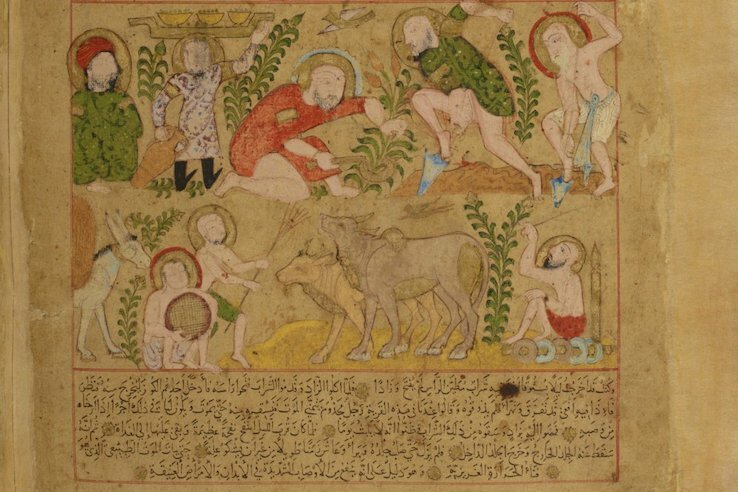
Alexander Knysh is Russian-American Professor of Islamic Studies at the University of Michigan and a specialist in the history of Sufism, the section editor for “Sufism” in the Encyclopedia of Islam, published by Brill. In his study “Sufism: a New History of Islamic Mysticism” (2017), he examines the evolution of Sufism in terms of how this movement was imagined in the writings of the Sufis themselves, their Muslim critics, and Western scholars. In his text for EastEast, Egor Korneev, an expert on the history of Islam, talks about the book and its main theses.
Sufism, or Tasawwuf (Arabic: تصوف), has remained an integral part of the Islamic tradition for over 1,000 years. During this period, the movement has spread to most areas of the Islamic world and to this day has an impact on the culture and religious life of the peoples of Western and Central Asia, Africa, and other regions. At the same time, modern researchers find it difficult to answer a seemingly simple question about what Sufism actually is. The reason lies in its diversity—and sometimes also in mutual contradictions—of doctrines and practices that in different historical periods and in different parts of the Muslim world were associated with this concept.
As a separate movement, Tasawwuf started its formation at the turn of the 8th—9th centuries among theologians and ascetics of Iraq. At the center of the first Sufis’ worldview lay the idea of personal and supersensible knowledge of God, which was possible through the renunciation of worldly goods and full concentration on one’s inner self-improvement. To achieve this goal, individual religious practices emerged within Sufi communities, such as, for example, dhikr—individual or collective repetition of prayers glorifying Allah. Moreover, the Sufis were distinguished by a special interest in studying the hidden meaning of the Quran—secret true knowledge available only to chosen Muslims. Based on the analysis of the Islamic sacred texts, they created teachings about the structure of the Universe and their own role in maintaining the existing world order.
Starting from the 11th century, Sufi teachers (sheikhs) began to form brotherhoods (tariqas) that differed from one another in teachings, rituals, and the principles of novices’ education (murids). Their popularity in various parts of the Muslim world grew until the turn of the 19th and 20th centuries. A significant part of Muslims from different social strata were involved in tariqas’ activities. In many ways, the success was due to the flexibility of Sufi doctrines and practices, which attracted both Muslim theologians and representatives of the urban poor, peasants, and trade and artisan representatives. In that period, maulids became especially popular—holidays held in honor of the founders of tariqas and other prominent Sufis (“friends of God” or saints), which were accompanied by pilgrimages to their tombs and public performance of dhikr.
In the 20th century, Sufism changed significantly. On the one hand, Sufis were criticized more often by the ideologues of the Salafi—a movement aimed at the purification of Islam from “unlawful innovations.” They still considered Tasawwuf one of the reasons for the cultural and political decline of the Muslim world and advocated refusal to participate in Sufi rituals and, in extreme cases, the elimination of its adherents. In the 20th century, modernization supporters also expressed a negative attitude towards Sufism, which they regarded as an obstacle to the secularization and development of Muslim societies. Despite constant criticism and the loss of influence, Tasawwuf managed to adapt to these new conditions and maintain its traditional dominance in several regions of the Islamic world, such as Yemen, Sudan and Upper Egypt, Chechnya, and Dagestan. It is important that during the same period Sufi sheikhs began spreading their influence in Europe and North America, where many viewed Sufism as an esoteric direction within the Islamic tradition.
Right: Attributed to Kamāl ud-Dīn Behzād. “Dancing Dervishes,” folio from a Divan of Hafiz. Circa 1480.
55.121.10.18, 17.81.4 / The Metropolitan Museum of Art
The diversity of modern Sufism results from its long evolution in various cultural, social, and political contexts. Today, both HadhramautHadhramautHadhramaut is a historical region in the south of the Arabian Peninsula, which is now part of the state of Yemen. peasants, who annually make pilgrimages to the local saints’ tombs, and prominent scholars of Cairo’s Al-Azhar—one of the most famous Islamic educational institutions in the world—can describe themselves as Sufis. The followers of Sufi sheikhs in the West, whose understanding of Tasawwuf is shaped by a particular cultural environment and mentality, also see themselves as a part of this spiritual tradition. On the whole, due to the striking diversity of Sufi ideas and practices, researchers find it increasingly difficult to answer an important question: what can be considered the core of this movement? Is it possible to form a common understanding of Tasawwuf that would be able to embrace all its forms?
It is this very question that underlies the study of the Russian-American Islamic scholar Alexander Knysh, Sufism: a New History of Islamic Mysticism (2017). Over the past 30 thirty years, Alexander Knysh has written several dozen works on the history of Tasawwuf and remains one of the leading experts in this field. One of the main goals of his latest book is to highlight numerous factors that shape our ideas about Sufism, and on their basis—to create its consistent image.
From the very beginning, the author argues that the complexity of Tasawwuf analysis has to do not only with the diversity of its doctrines and practices, but also with the fact that this movement is imagined in completely different ways within the framework of various intellectual traditions. Throughout its history, Sufism has been continuously rethought both by Sufis-insiders themselves and by outside observers—primarily Muslim critics of this movement—,and later by its Western researchers. The author shows that these communities’ perceptions of Tasawwuf differ considerably from one another, since they were formed in different conditions and with different motivations. For example, Sufis themselves have always insisted on the full compliance of their beliefs and practices with the Quran, as well as on their own exclusive role as the transmitters of secret knowledge inaccessible to other Muslims. At the same time, Shiite theologians did not stop claiming that Sufism was a distorted version of the “correct” esotericism found exclusively in the Shiite religious tradition. Another concept of Tasawwuf was actively promoted by oriental scholars of the 19th—20th centuries who fundamentally shared Sufi doctrines and practices. Western experts considered many Sufi rites to be merely a vulgar interpretation of elevated ideas and therefore singled them out as an artificial category of “the cult of saints.” Thus, they narrowed the definition of Tasawwuf down to a set of theoretical ideas about the knowledge of God and the structure of the Universe free from irrational rituals and popular superstitions.
Analyzing various ways of describing Sufism, the author seeks to convey to the reader one important idea: a full-fledged study of Tasawwuf is possible only through the appeal to its various interpretations, proposed by both Sufi tradition insiders and outsiders. Knysh emphasizes that bias and partisanship were characteristic of all the authors who have ever tried to approach Sufism—without exception: the Sufis themselves, their Muslim critics, and Western researchers. Each of these communities paid attention to some aspects of this phenomenon and, for a number of subjective reasons, preferred to ignore the other manifestations. Thus, the task of a modern researcher is to thoroughly analyze all these ideas about Sufism and to use this basis to form a multifaceted, balanced image of the movement. Knysh examines numerous issues—from the process of Sufi moral code formation to a critical analysis of Western theories of the emergence of Tasawwuf. He pays attention to both Sufism formations and contemporary socio-political processes associated with the Sufi tradition in the Caucasus, Yemen, and North America. Using this extensive material, the author tries to solve one of the main tasks of the book—to create an umbrella definition of Tasawwuf that would embrace all its diverse forms.
For Knysh, Sufism is primarily an “impressive monument to human creativity” and adherence to higher spiritual ideals
To reach this goal, Knysh introduces several terms that describe the Sufi movement from different perspectives. First, he marks Tasawwuf as a mystical-ascetic trend in Islam. This characteristic emphasizes, on the one hand, the Sufis’ focus on the supersensible, irrational knowledge of God and, on the other hand, their tendency to renounce worldly goods and constantly discipline the body. Although the term “mystical-ascetic movement” seems to be an effective means to describe Tasawwuf, in fact it does not take into account important nuances and is often criticized among researchers. Firstly, mysticism and asceticism are not unique characteristics of Sufism, since we find a similar attitude to religious experience in other areas of Islam—in particular, among various Shiite communities: the adherents of Isnaasharit, Ismailism, the Druze faith, and others. Secondly, nowadays many researchers criticize the use of the term “mysticism” not only in relation to Tasawwuf, but to any other religious traditions of the East. This is connected to the works of Michel de Certeau and Richard King in the 1980s and 1990s, where they examined the formation of the concept of “mysticism” in the Western intellectual tradition. According to their conclusions, this category narrows our ideas about numerous religious movements, since it takes into consideration exclusively the experience of personal and irrational interaction with the Divine, while Sufism, like many other “mystical” movements, is not limited to the sphere of believers’ personal relations with God, as it also affects the spheres of the Muslim communities’ political and social structures.
The second basic characteristic of Sufism is the concept of Islam in miniature. According to the author, all the main features of Islam are duplicated within the framework of the Sufi movement, which is one of its parts. In particular, Islam and Tasawwuf consist of five basic components, without which the formation and reproduction of these traditions would be impossible. These include teachings (discourses), doctrine-driven practices, communities of experts in the tradition their followers are guided by, social institutions that create the necessary environment for the transmission of traditions and the implementation of practices, and leaders who interpret teachings for believers, monitor the observance of rituals, control the functioning of institutions, and identify key fundamental vectors for the development of religious tradition.
Based on these two terms, Knysh offers a detailed definition of Tasawwuf. He describes this multifaceted phenomenon by means of “constants”—distinguishing characteristics of Sufi doctrines and practices. Thus, the author proposes eight provisions and invites their criticism and redefinition in order to ultimately create the most simple, but at the same time most nuanced definition of the Sufi movement. In a nutshell, the constants of Sufism can be described in the following way:
Knysh uses these constants to expand our understanding of Tasawwuf and create the basis for its further analysis. Emphasizing the elasticity of the concept of “Sufism,” he nevertheless gives it a new definition that takes into account the diversity and richness inherent in this tradition. It is important to mention that the author wants to highlight the significance and potential of Tasawwuf as an component of Islam that does not lose its relevance and attractiveness to believers, even in the face of widespread criticism. For Knysh, Sufism is primarily an “impressive monument to human creativity” and adherence to higher spiritual ideals—something that ensures its constant popularity among Muslims.
Translated from Russian by Olga Bubich









